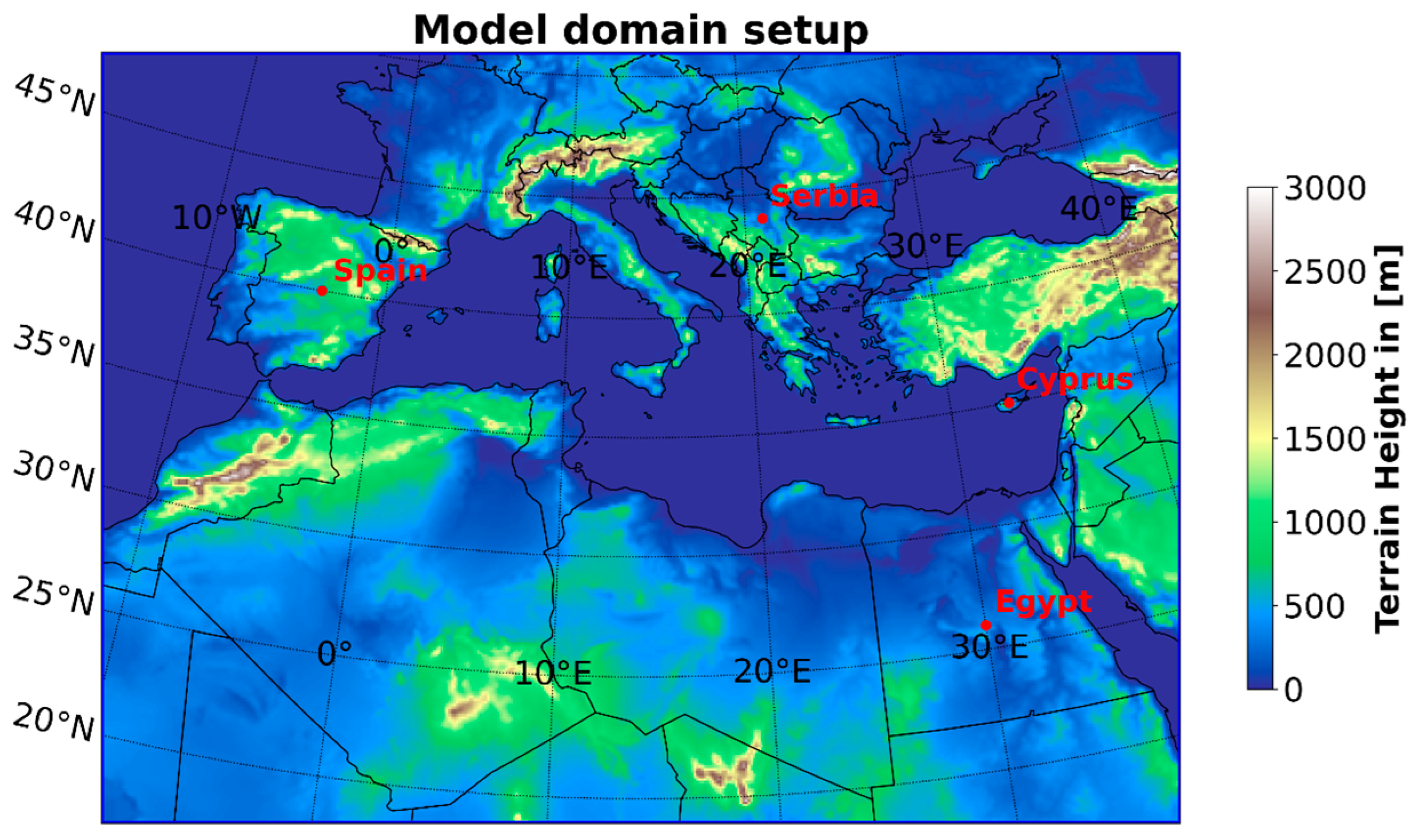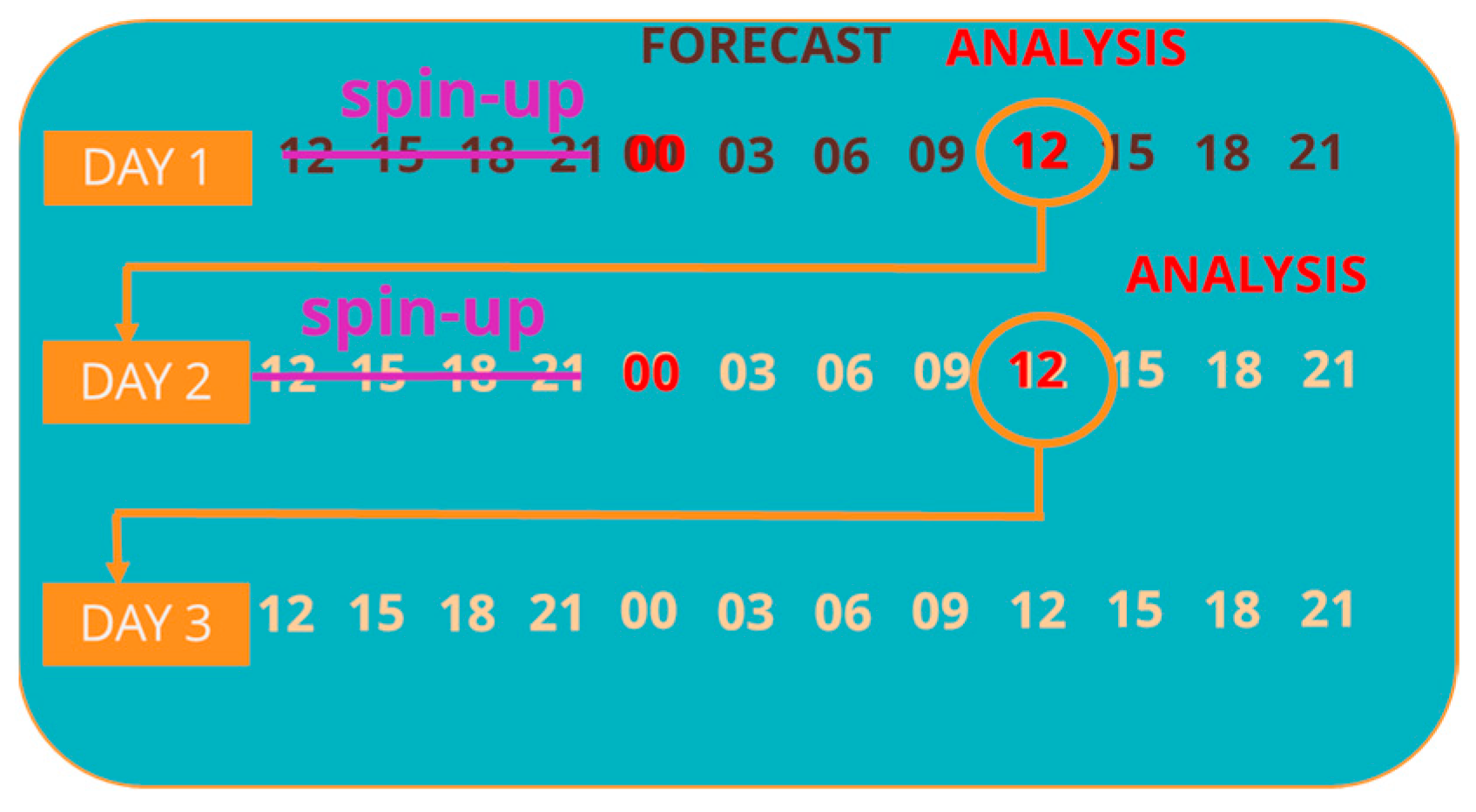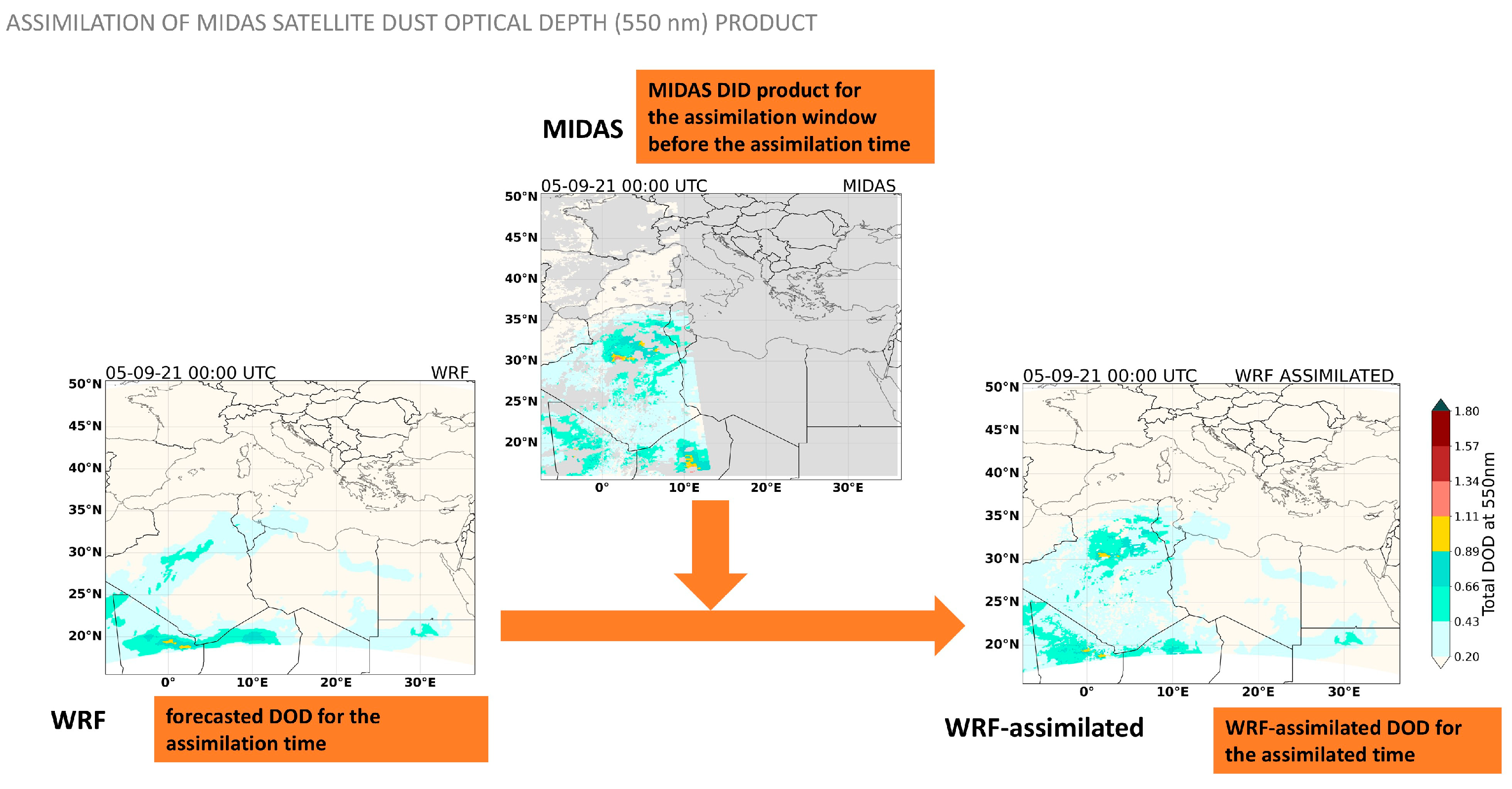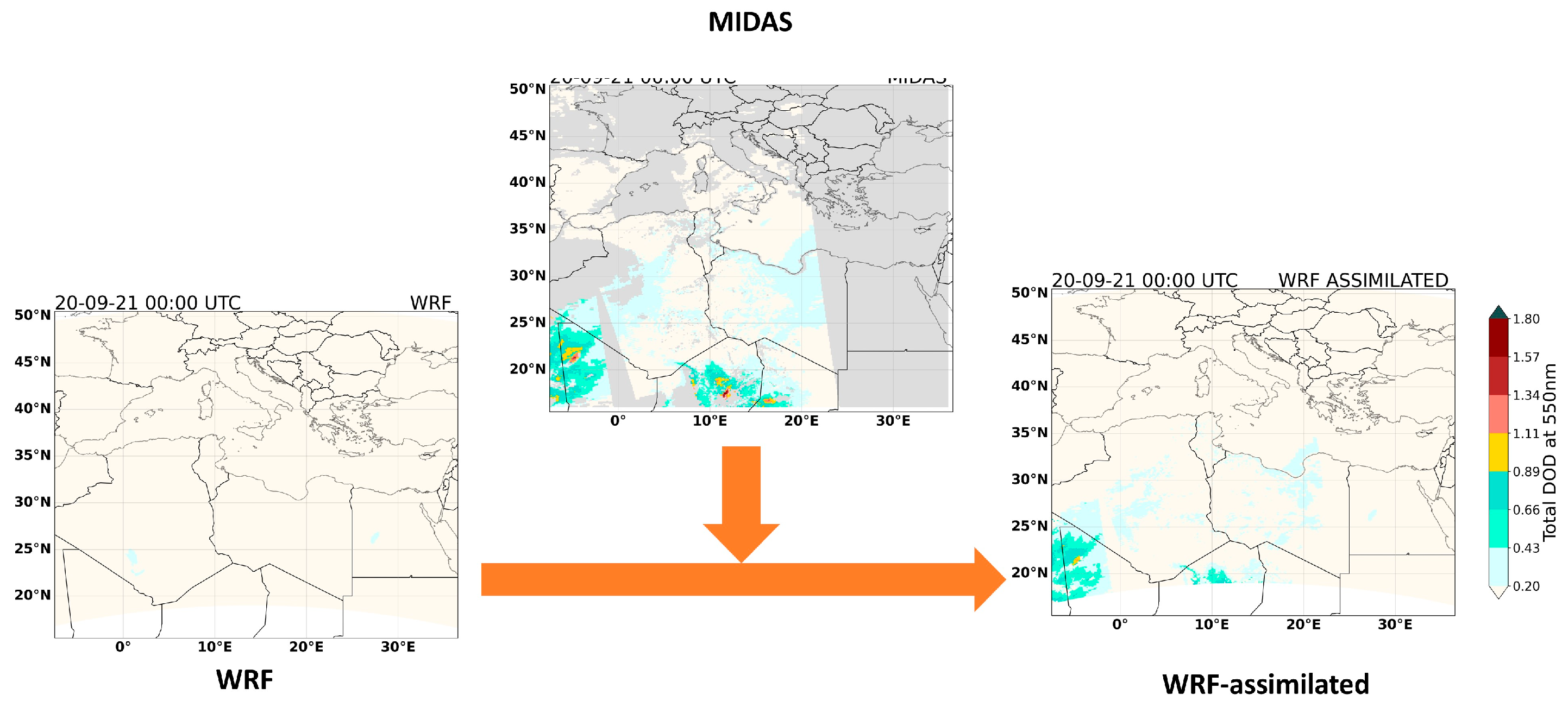1. Introduction
Atmospheric aerosols, and, in particular, desert dust, play a critical role in the Earth’s climate system, air quality, and human health [
1]. Dust storms originating from arid regions such as the Sahara can be transported over long distances, affecting large parts of the Mediterranean basin and Europe [
2,
3]. Accurate simulation of dust events is essential for both scientific understanding and operational forecasting, especially in regions regularly impacted by long-range dust transport. However, modeling the emission, transport, and deposition of mineral dust remains challenging due to various sources of uncertainty—particularly those associated with the spatial and temporal variability of dust sources, meteorological conditions, and the representation of aerosol processes within models [
4]. To reduce these uncertainties, data assimilation techniques are increasingly employed, combining observations with numerical models to improve the accuracy of aerosol forecasts. Recent advancements in satellite remote sensing and ground-based networks have enhanced the availability and quality of aerosol observations, enabling the development of integrated assimilation systems for desert dust. These systems leverage satellite-derived aerosol optical depth (AOD) products and in situ measurements to constrain and update aerosol fields in real time. This study presents a dust assimilation framework developed in the context of the CiROCCO project, aiming to improve model performance over the Mediterranean region through the assimilation of satellite-based dust observations. The system is implemented using the WRF-Chem model [
5] and employs a Newtonian relaxation approach to adjust modeled dust concentrations based on satellite-derived dust optical depth (DOD). The overarching goal is to improve the representation of desert dust in atmospheric models and contribute to more reliable dust forecasts and air quality assessments.
2. Materials and Methods
2.1. MIDAS Product
For the assimilation of dust optical depth (see
Section 2.2,
Section 2.3 and
Section 3), the recently developed MIDAS dataset [
6] has been utilized. MIDAS has been produced via the synergy of the quality-filtered MODIS aerosol optical depth (AOD, Collection 6.1, Level 2) and the fraction of AOD attributed to dust (MDF), provided by the Modern-Era Retrospective Analysis for Research and Applications (MERRA-2 version 2). According to the applied methodology, the columnar DOD at 550 nm is derived at fine spatial grid spacing (0.1° × 0.1°), along with its associated uncertainty (see [
6] (Sect. 3)). MIDAS DOD has been evaluated versus AERONET AOD retrievals [
7], in which the contribution of non-dust aerosol species has been minimized. In the region of interest of the current study (Sahara and Mediterranean), MIDAS DODs covariate (R ~0.90) very well with AERONET-derived DODs, although they are slightly overestimated by <0.04 (see [
6] (Figure 4)). Moreover, the intercomparison of MIDAS, LIVAS, and MERRA-2 DODs show a remarkable consistency in reproducing the seasonal cycle of dust loads over Sahara. Overall, the MIDAS dataset is quite useful for the current study, due to the high reliability of the derived DOD product and the product availability at fine spatial resolution, daily.
2.2. WRF-Chem Model and Set-Up
The WRF-Chem model version 4.2.1 [
5,
8] is employed over a domain covering the broader Mediterranean region, with a horizontal resolution of 12 × 12 km (see
Figure 1). The domain encompasses key pilot areas—Egypt, Cyprus, Serbia, and Spain—as well as all major desert dust source regions influencing the study area. Meteorological forcing is provided by the Global Forecast System (GFS) [
9].
2.3. Assimilation Method
We employ a Newtonian relaxation (nudging) approach for the assimilation of dust-related satellite observations [
10], specifically applied here to the assimilation of satellite-derived dust optical depth (DOD). This technique has been previously developed and operationally implemented at the Serbian National Meteorological Service (South East European Virtual Climate Change Center—SEEVCCC) for assimilating the ECMWF-MODIS dust product into the DREAM model [
10], as well as in the NMM-DREAM system for assimilating the MSG-SEVIRI DOD product [
11]. In this framework, the prognostic dust concentration field (
C) is gradually nudged toward the satellite-observed field (
CT), following the Newtonian relaxation formulation presented in Equation (1). The rate of nudging is controlled by a user-defined relaxation coefficient (
k), which governs the strength of the adjustment.
The assimilation routine is implemented as a stand-alone Python module, allowing flexible integration into the WRF-Chem workflow and compatibility with various satellite input formats. The model operates in an operational-like mode, producing daily 36 h forecasts over a 14-day period (8–21 September), each initialized at 12:00 UTC without assimilation. After each forecast, a 12 h assimilation window is applied. The first 12 h are treated as spin-up and excluded, while the subsequent 00:00 UTC and 12:00 UTC forecast fields are corrected using MIDAS DOD observations [
6], generating assimilated outputs at 12 h intervals. The 12:00 UTC analysis is then used to initialize the dust field for the next cycle, enabling each forecast to benefit from the preceding analysis. This approach yields a continuous dataset combining analysis and forecast fields. The full procedure is illustrated in
Figure 2.
3. Results
A preliminary assessment of the assimilation system was performed over a 14-day period, spanning from 8 to 21 September 2021.
Figure 3 and
Figure 4 illustrate the spatial distribution of dust fields for two representative snapshots within the simulation window—05 September 2021 at 00:00 UTC and 20 September 2021 at 12:00 UTC—allowing for a visual comparison between the control (non-assimilated) and assimilated model outputs. The results demonstrate a clear improvement in the alignment between the model-predicted and satellite-observed dust optical depth (DOD), particularly in regions exhibiting strong gradients or localized dust activity.
This initial application suggests that the Newtonian relaxation technique successfully adjusts the dust concentration fields, leading to a more realistic representation of aerosol loading. While these qualitative results are promising, a more robust, quantitative evaluation—based on ground-based particulate matter (PM) observations from the pilot areas—is required to objectively verify and statistically quantify the improvements introduced by the assimilation system. The integration of such validation data will be a key step toward the operational deployment and further optimization of the methodology.
4. Discussion and Future Work
In this study, a Newtonian relaxation method was applied to assimilate satellite-derived dust optical depth (DOD) from the MIDAS dataset. This approach provides a practical balance between simplicity and computational efficiency, making it suitable for regional, semi-operational applications compared to more complex techniques like Kalman Filters or variational assimilation.
Initial results are promising, showing that the method effectively adjusts modeled dust fields toward satellite observations. However, a key limitation is its inability to constrain the vertical distribution of dust, as DOD is a column-integrated quantity. This may lead to uncertainties in radiative effects, transport, and surface-level concentrations.
Future work may incorporate vertically resolved products, such as extinction profiles from upcoming missions like ESA’s EarthCARE, to improve 3D dust representation. This method will also be applied during the CiROCCO field campaign in summer 2025, which will provide AOD and PM2.5/PM10 data from remote, arid regions. These in situ observations will be critical for validating and refining the assimilation system.
Author Contributions
Conceptualization, V.A. and E.D.; software, E.D.; validation, E.D. and T.G.; writing—original draft preparation, E.D.; writing—review and editing, E.D., V.A., and T.G. All authors have read and agreed to the published version of the manuscript.
Funding
This research has been supported by the EU-funded project CiROCCO under Grant Agreement No 101086497. Views and opinions expressed are, however, those of the authors only and do not necessarily reflect those of the European Union or REA. Neither the European Union nor REA can be responsible for them.
Institutional Review Board Statement
Not applicable.
Informed Consent Statement
Not applicable.
Data Availability Statement
Conflicts of Interest
The authors declare no conflicts of interest.
Abbreviation
The following abbreviation is used in this manuscript:
References
- Mineral Dust: A Key Player in the Earth System; Knippertz, P., Stuut, J.-B.W., Eds.; Springer: Dordrecht, The Netherlands, 2014; ISBN 978-94-017-8977-6. [Google Scholar]
- Gkikas, A.; Houssos, E.E.; Lolis, C.J.; Bartzokas, A.; Mihalopoulos, N.; Hatzianastassiou, N. Atmospheric Circulation Evolution Related to Desert-dust Episodes over the Mediterranean. Q. J. R. Meteorol. Soc. 2015, 141, 1634–1645. [Google Scholar] [CrossRef]
- Marinou, E.; Amiridis, V.; Binietoglou, I.; Tsikerdekis, A.; Solomos, S.; Proestakis, E.; Konsta, D.; Papagiannopoulos, N.; Tsekeri, A.; Vlastou, G.; et al. Three-Dimensional Evolution of Saharan Dust Transport towards Europe Based on a 9-Year EARLINET-Optimized CALIPSO Dataset. Atmos. Chem. Phys. 2017, 17, 5893–5919. [Google Scholar] [CrossRef]
- Gliß, J.; Mortier, A.; Schulz, M.; Andrews, E.; Balkanski, Y.; Bauer, S.E.; Benedictow, A.M.K.; Bian, H.; Checa-Garcia, R.; Chin, M.; et al. AeroCom Phase III Multi-Model Evaluation of the Aerosol Life Cycle and Optical Properties Using Ground- and Space-Based Remote Sensing as Well as Surface in Situ Observations. Atmos. Chem. Phys. 2021, 21, 87–128. [Google Scholar] [CrossRef]
- Grell, G.A.; Peckham, S.E.; Schmitz, R.; McKeen, S.A.; Frost, G.; Skamarock, W.C.; Eder, B. Fully Coupled “Online” Chemistry within the WRF Model. Atmos. Environ. 2005, 39, 6957–6975. [Google Scholar] [CrossRef]
- Gkikas, A.; Proestakis, E.; Amiridis, V.; Kazadzis, S.; Di Tomaso, E.; Tsekeri, A.; Marinou, E.; Hatzianastassiou, N.; Pérez García-Pando, C. ModIs Dust AeroSol (MIDAS): A Global Fine-Resolution Dust Optical Depth Data Set. Atmos. Meas. Tech. 2021, 14, 309–334. [Google Scholar] [CrossRef]
- Giles, D.M.; Sinyuk, A.; Sorokin, M.G.; Schafer, J.S.; Smirnov, A.; Slutsker, I.; Eck, T.F.; Holben, B.N.; Lewis, J.R.; Campbell, J.R.; et al. Advancements in the Aerosol Robotic Network (AERONET) Version 3 Database—Automated near-Real-Time Quality Control Algorithm with Improved Cloud Screening for Sun Photometer Aerosol Optical Depth (AOD) Measurements. Atmos. Meas. Tech. 2019, 12, 169–209. [Google Scholar] [CrossRef]
- Skamarock, W.C.; Klemp, J.B.; Dudhia, J.; Gill, D.O.; Liu, Z.; Berner, J.; Wang, W.; Powers, J.G.; Duda, M.G.; Barker, D.M.; et al. A Description of the Advanced Research WRF Model Version 4; National Center for Atmospheric Research: Boulder, CO, USA, 2021. [CrossRef]
- NCEP GFS 0.25 Degree Global Forecast Auxiliary Grids Historical Archive; National Centers For Environmental Prediction/National Weather Service/NOAA/U.S. Department Of Commerce: College Park, MD, USA, 2015; d084003.
- Pejanovic, G.; Nickovic, S.; Petkovic, S.; Vukovic, A.; Djurdjevic, V.; Vujadinovic, M.; Dacic, M. Dust Operational Forecast System with Assimilation of Dust Analysed Data. In Proceedings of the Regional Conference on Dust and Dust Storms, Kuwait City, Kuwait, 20–22 November 2012; pp. 20–22. [Google Scholar]
- Solomos, S.; Nickovic, S.; Amiridis, V.; Pejanovic, G.; Pradhan, Y.; Marenco, F.; Petkovic, S.; Marinou, E.; Cvetkovic, B.; Kontoes, C. Development of a Dust Assimilation System for NMM-DREAM Model Based on MSG-SEVIRI Satellite Observations. In Perspectives on Atmospheric Sciences; Karacostas, T., Bais, A., Nastos, P.T., Eds.; Springer International Publishing: Cham, Switzerland, 2017; pp. 801–807. ISBN 978-3-319-35094-3. [Google Scholar]
| Disclaimer/Publisher’s Note: The statements, opinions and data contained in all publications are solely those of the individual author(s) and contributor(s) and not of MDPI and/or the editor(s). MDPI and/or the editor(s) disclaim responsibility for any injury to people or property resulting from any ideas, methods, instructions or products referred to in the content. |
© 2025 by the authors. Licensee MDPI, Basel, Switzerland. This article is an open access article distributed under the terms and conditions of the Creative Commons Attribution (CC BY) license (https://creativecommons.org/licenses/by/4.0/).









